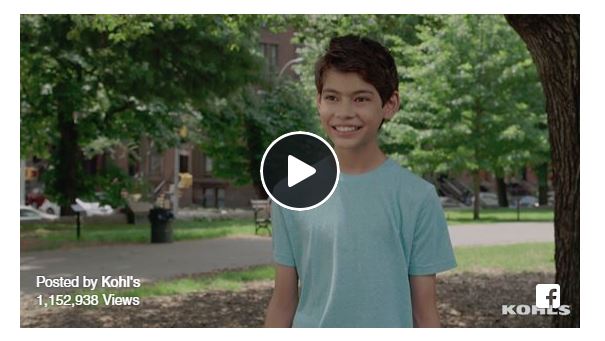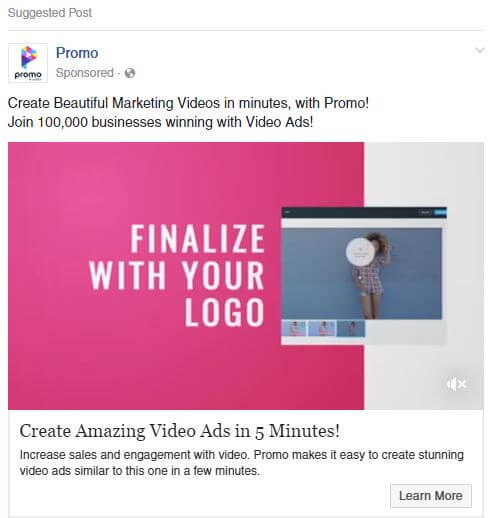Case studies
Industries
Resources
TikTok Collection
NEW
Table of Contents
Like it or not, we’ve entered an era of marketing absolutely dominated by video ads.
And guess what? It’s been a long time coming.
For years, video has been heralded as the future of content marketing; however, it’s rather clear that this once-speculated future has indeed arrived.
Think about it. Within the span of a decade, YouTube has gone from a secondary, seemingly “unknown” advertising channel to a marketing powerhouse, boasting over two billion monthly active users and ranking as the second most-visited site online today.
While once considered a novelty to marketers, the video is well-documented to have one of the best ROI’s in terms of content marketing. With brands scoring more click-throughs and conversions via visual content than ever before, it’s no surprise that more and more marketers have hopped on board.
Among the many varieties of visual content, social video has exploded in its own right.
Facebook alone is responsible for over eight billion video views per day and is currently reeling in viewers through Facebook Live (at three times the rate of a normal video).
Meanwhile, platforms such as Instagram and Snapchat have turned the world of video marketing upside down, with the latter’s $3.4 billion IPO turning heads as marketers strive to understand the untapped potential of video marketing.

But as the stats supporting the rise of video ads for marketers are certainly a positive notion, a challenge presents itself: fierce competition as more and more brands hop on the video bandwagon.
The good news? For starters, the barrier to entry when it comes to producing video ads for any given business is arguably lower than ever. The aforementioned rise of Facebook live and platforms such as Snapchat signal fewer expectations from users in terms of production quality. Car vlogging and cell phone videos are fair game for converting modern customers; meanwhile, the ability to upload video directly to any given social platform means less of an expectation for editing expertise.
That being said, it’s crucial for eCommerce brands, in particular, to have goals and a strategy in mind when it comes to integrating video ads into their content campaign. For most brands, this means a three-pronged approach which…
Given the many moving pieces, getting started with video ads can be a bit overwhelming; however, video marketing becomes much easier when you take a step back and ask yourself one crucial question: what does my audience want?
Video ads aren’t inherently different from any other sort of marketing campaign as it’s paramount that you know exactly what you’re investing in before you begin. Although you don’t necessarily need a bloated budget to leverage video, you do need a sense of what are the best practices for your niche.
Specifically, you need to know a combination of the following in regard your industry and, most importantly, your audience:
All things considered, there is no “best” platform for running video ads. However, there are some distinct differences between the major social channels in terms of formatting and best practices.
How so? Let’s break down the biggest players below.
Facebook affords marketers flexibility in regard to video ads: pretty much anything, from bite-sized snippets to full-length commercials are fair game. As an added bonus, videos published via Facebook can serve as sleek native ads elsewhere (such as your homepage or landing page). The following example from Kohl’s shows off what such a native ad would look like on-site.

Pretty clean, right? This is good news for those who want to double-dip their social video ads with on-site content instead of trying to host their videos in multiple places.
One aspect of Facebook videos that you can’t afford to ignore is sound.
Given that 85% of Facebook users watch video ads with the sound off, (even though Facebook is trying really hard to make users see the videos with the sound on) you need to make sure that your ads have captions, subtitles or are broken up with text to illustrate what exactly is going on in case users are scrolling through your ad.
Here’s an example from a sponsored post in my own newsfeed for Promo which is, ironically, a resource for creating video ads:

Generally speaking, popular video ads on Instagram are not akin to traditional commercials. Oftentimes, they resemble something closer to User Generated Content by incorporating people and showing off products in action. With Instagram’s one-minute video limit, it’s crucial that brands make their videos bite-sized or flashy enough to stand out from the pack.
The following from CLUSE is a notable example of a brief yet effective video ad using quick cuts and a model showing off their high-end watches:
Curious about how Flowbox can transform your marketing strategy by pulling useful content from social media networks? Get your demo now!
Considering that the cost of running Snapchat ads is fairly steep (think: tens of thousands of dollars), many brands are opting to use the platform’s “Stories” feature to engage followers. Since selling via Snapchat is largely unexplored territory (although Warby Parker did release an exclusive pair of sunglasses through the platform), humorous “slice of life” videos such as this example from HubSpot are the platform’s bread and butter.

YouTube is more-so a content distribution platform versus a social network; however, it does harbor its own community and massive audience, therefore deserving the attention of any budding brand. Likewise, YouTube is a prime channel for generating leads and getting more mileage out of your video content. For example, here’s an example of a video ad from Ipsy which is both present on their YouTube channel and Instagram:
Marketing video ads on Twitter requires a strategy that sits somewhere between Facebook and Instagram. Just about any type of video is welcome, but traditionally shorter videos take the cake. CoSchedule notes that over 80% of Twitter’s users engage with video, so the platform is more than worthy of your attention.
If you’re game for experimentation, you can take a stab at bite-sized, TikTok/Instagram Reels-style videos that receive lots of buzz such as this example from Zappos:
At the end of the day, your brand’s ideal platform will be based on a single, essential question: where are your users hanging out?
If you have an answer, start there and only there instead of trying to dominate each and every social site with video ads (hint: you’ll burn yourself out trying).
So, let’s say you have a platform in mind. What type of video ads should you produce?
Overwhelmed by these examples and all of the potential videos you can make?
Don’t be.
When you break it down, there are two primary types of video ads any given brand can produce. Yes, there are millions of approaches you can take, but when it all boils down, effective video ads can be separated into two major categories.
These videos are akin to a traditional commercial. Such videos may include announcements of product launches, showing off a new product or something else deemed buzzworthy. Oftentimes, they’re bold and demand your attention (especially in the fashion space). Check out this example from Black Milk:
Traditional commercials can be effective if and only if the products featured are allowed to speak for themselves. If nobody knows who you are or you’re not as established as a brand, it may be more prudent to take a different approach to your video ads.
What does that approach look like?
How-to and tutorial-style content have always been a cornerstone of modern content marketing. After all, such content isn’t in-your-face or salesy, but rather integrates products into a real-world setting to solve the problems of an audience.
Educational video content is centered around a simple concept: what can your product do?
Now, show me.
Don’t tell me. Show me.
Film it.
Beardbrand’s YouTube channel is a seemingly bizarre but shining example of the power of how-to content. Nearly all of their videos boast hundreds of thousands of views with thousands of shares via social. And guess what? They’re all centered around advice which integrates their brand of high-end men’s grooming products into their content.
By consistently solving the problems of their audience, they engage and show off what they’re selling. In short, it’s a win-win situation: they don’t have to shove products in the faces of their audience, but the viewers still get to see the products in action.
Spoiler Alert: Video Ads Don’t Require a Professional Studio.
As a quick aside and as noted earlier, you do not need a studio or high-definition camera to create video ads. While some of the previous examples obviously employ professional equipment, that doesn’t mean that you have to.
Seriously.
With the rise of Facebook Live, platforms such as Snapchat and laid-back YouTube vloggers, everything you need to start producing video content is already built into your smartphone. Likewise, video ads which are text and static image-heavy don’t require much editing process.
Again, the barrier to entry for video ads is lower than ever. With all of the options available to you, your budget is no longer an excuse not to get started.
Finally, let’s talk about some best practices for video ads regardless of the platform or industry. The following five principles can be applied to just about any video marketing campaign and should, therefore, be in the back of your mind before you publish your own content.
If possible, avoid the traditional sales pitch like the plague. Many of the most popular video ads take a humorous approach (such as the The Beard Club example below which has over 3 million views), but the tone of your ads is heavily dependent on your industry. Regardless, make sure to stay in line with your respective brand and relay a message that resonates with your audience.
Bear in mind that your video ads will be judged, and likewise glanced over, in a matter of seconds. To avoid getting scrolled past, consider bright colors, bold fonts and eye-popping imagery within the first few frames of your ad. This advice also rings true for your thumbnail (see Beardbrand’s example above).
As is the case of copywriting, sometimes it pays to be punchy versus long-winded. If your video ad can get its message across in a few seconds versus a few minutes, the shorter version is more than likely a winner. A reliable video cutter can help you trim down your content precisely, ensuring your message stays impactful.
If you want viewers to ride the buzz of your videos, you have to give them something to do afterward. Whether that means checking out a sale at your store or sharing with a friend, effective ads encourage engagement.
In order to get the most mileage out of your content, strive to saturate your videos throughout multiple channels. For example, you can feature your video in a blog post; likewise, you can use the content from your videos as a separate piece of written content.
The concept of video marketing representing a “secondary” channel is quickly becoming a relic of the past. Given that video consumption is at an all-time high, brands who embrace video ads will not only stand out versus the competition but also keep up with the expectations of modern consumers. Given that there is no one-size-fits-all approach to video marketing, those with the creative touch who can truly speak to the needs of their audience will naturally rise to the top.
What do you think makes a truly effective video ad? If you haven’t gotten involved with video, what’s been holding you back?